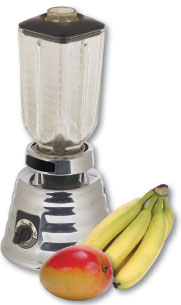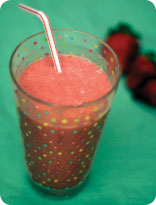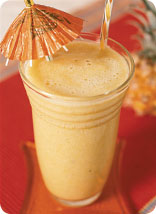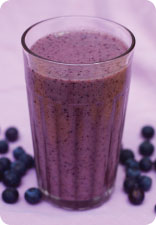Smooth Moves
By Candy Sagon
Photographs by Robb Hill
Thick, frozen fruit smoothies are a great pick-me-up and a nutritious treat for a quick breakfast or den meeting snack.
They're a meal in a glass, a fun snack, and a nutritious beverage. No wonder Americans, from adults to kids, love smoothies. In fact, we love them so much that in 2007 we slurped up an estimated $2.3 billion in smoothie sales at cafés, juice bars, and health-food stores across the country.
 Yet buying made-to-order smoothies is only one way to enjoy them. They’re just as easy to make at home. The homemade version will cost you less and can also mean fewer calories than the juice-bar kind that frequently comes in super-size portions.
Yet buying made-to-order smoothies is only one way to enjoy them. They’re just as easy to make at home. The homemade version will cost you less and can also mean fewer calories than the juice-bar kind that frequently comes in super-size portions.
Think of the smoothie solution for a healthy snack for the Cub Scout den meeting, a quick breakfast before school, or a nutritious pick-me-up before the next round of carpooling, errands, or appointments.
Purists will say that the original smoothie was made with only fresh fruit, fruit juice, and ice, blended to a thick, slushy consistency -- and that’s certainly a delicious, no-fat way to make them. But today’s smoothies are just as likely to contain yogurt or soy milk to give them creaminess, plus any number of optional ingredients, including echinacea and ginseng to give them a boost of nutrients.
When making smoothies at home, you don’t need to follow any precise formula. Basically, just get a blender, fresh or frozen fruit, a little liquid, and something to thicken the drink. Crushed ice can thicken without added calories, but yogurt adds flavor as well as calcium. For those who must avoid dairy, soy yogurt or tofu are good alternatives; or do what cookbook author Mark Bittman does: Add a frozen banana.
Depending on the ingredients, you can make your smoothie as creamy as a milkshake, but with fewer calories and fat, or as cool and refreshing as a glass of lemonade, but with more vitamins and nutrients.
Keep these tips in mind:
Try frozen fruit. It produces a thicker, colder smoothie than fresh, so you can use less ice to get that slushy consistency. And frozen is a good option when fresh fruits such as berries, peaches, and mangoes aren’t in season.
Add liquid. Unless you’re using a thin yogurt, you’ll need a little juice, milk, even water to get the ingredients to blend easily. For more nutrition, use calcium-fortified juice and skim or low-fat milk.
Help your blender. Because blender strength varies, add ice or big frozen chunks of fruit first and briefly blend to chop them into smaller pieces. Then add the rest of the ingredients.
Remember the 1-cup formula. The UC Berkeley Wellness Letter offers this simple formula for any smoothie: 1 cup fruit, 1 cup liquid (yogurt, milk, juice), 1 tablespoon sweetener (honey, maple syrup), plus six ice cubes. If you use tofu as the liquid, blend in only one-half cup of the soft, silken variety.
Experiment. Add a little coconut milk for a tropical flavor; try different juices such as cranberry, pineapple, or papaya nectar; and add some spice, say one-half teaspoon of fresh ginger or cinnamon.
Candy Sagon is a former food writer at The Washington Post.
|
|
|
 Strawberry-Orange Smoothie
Strawberry-Orange Smoothie Tropical Mango Smoothie
Tropical Mango Smoothie Blueberry Blast Smoothie
Blueberry Blast Smoothie